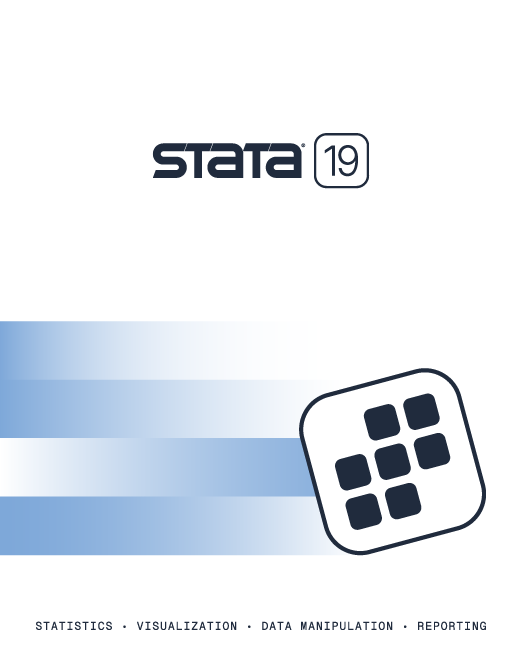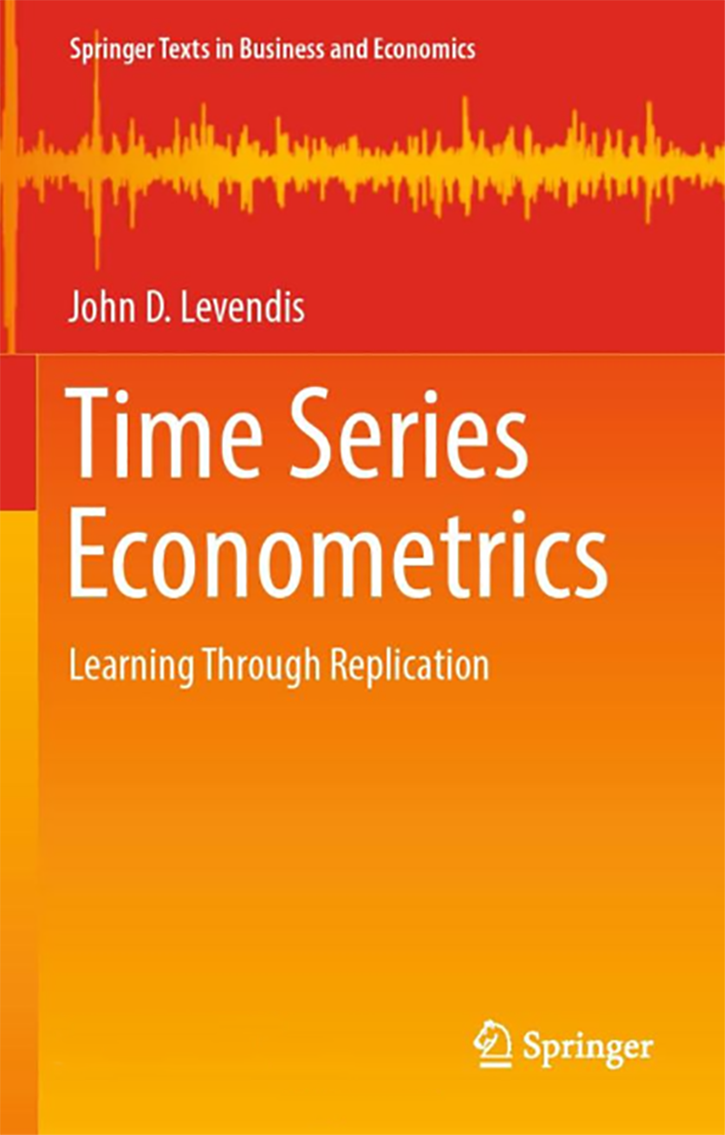

Time Series Econometrics: Learning Through Replication |
||||||||||||||||||||||||||||||||
 Click to enlarge See the back cover |

As an Amazon Associate, StataCorp earns a small referral credit from
qualifying purchases made from affiliate links on our site.
eBook not available for this title
eBook not available for this title |
|
||||||||||||||||||||||||||||||
Comment from the Stata technical groupJohn D. Levendis's Time Series Econometrics: Learning Through Replication is a time-series book for practitioners from an author that has published numerous Stata Journal articles that provide helpful tools for financial analysts. The topics covered range from univariate time-series models under stationarity and nonstationarity to multivariate time-series models, ARCH models, and GARCH models. The theory is presented clearly, but the focus always goes back to showing the practitioner how to use Stata's estimation and postestimation tools to answer relevant research questions. The datasets, examples, and exercises are carefully chosen and are a noteworthy part of the text. |
||||||||||||||||||||||||||||||||
Table of contentsView table of contents >> 1 Introduction
1.1 What Makes Time-Series Econometrics Unique?
1.2 Notation 1.3 Statistical Review 1.4 Specifying Time in Stata 1.5 Installing New Stata Commands 1.6 Exercises 2 ARMA(p,q) Processes
2.1 Introduction
2.1.1 Stationarity
2.2 AR(1) Models2.1.2 A Purely Random Process
2.2.1 Estimating an AR(1) Model
2.3 AR(p) Models2.2.2 Impulse Responses 2.2.3 Forecasting
2.3.1 Estimating an AR(p) Model
2.4 MA(1) Models2.3.2 Impulse Responses 2.3.3 Forecasting
2.4.1 Estimation
2.5 MA(q) Models2.4.2 Impulse Responses 2.4.3 Forecasting
2.5.1 Estimation
2.6 Non-zero ARMA Processes2.5.2 Impulse Responses
2.6.1 Non-zero AR Processes
2.7 ARMA(p,q) Models2.6.2 Non-zero MA Processes 2.6.3 Dealing with Non-zero Means
2.7.1 Estimation
2.8 Conclusion3 Model Selection in ARMA(p,q) Processes
3.1 ACFs and PACFs
3.1.1 Theoretical ACF of an AR(1) Process
3.2 Empirical ACFs and PACFs3.1.2 Theoretical ACF of an AR(p) Process 3.1.3 Theoretical ACF of an MA(1) Process 3.1.4 Theoretical ACF of an MA(q) Process 3.1.5 Theoretical PACFs 3.1.6 Summary: Theoretical ACFs and PACFs
3.2.1 Calculating Empirical ACFs
3.3 Putting It All Together3.2.2 Calculating Empirical PACFs 3.4 Information Criteria 4 Stationarity and Invertibility
4.1 What Is Stationarity?
4.2 The Importance of Stationarity 4.3 Restrictions on AR coefficients Which Ensure Stationarity
4.3.1 Restrictions on AR(1) Coefficients
4.4 The Connection Between AR and MA Processes4.3.2 Restrictions on AR(2) Coefficients 4.3.3 Restrictions of AR(p) Coefficients 4.3.4 Characteristic and Inverse Characteristic Equations 4.3.5 Restrictions on ARIMA(p,q) Coefficients
4.4.1 AR(1) to MA(∞)
4.5 What Are Unit Roots, and Why Are They Bad?4.4.2 AR(p) to MA(∞) 4.4.3 Invertibility: MA(1) to AR(∞) 5 Non-stationarity and ARIMA(p,d,q) Processes
5.1 Differencing
5.1.1 Example of Differencing
5.2 The Random Walk
5.2.1 The Mean and Variance of the Random Walk
5.3 The Random Walk with Drift5.2.2 Taking the First Difference Makes it Stationary
5.3.1 The Mean and Variance of the Random Walk with Drift
5.4 Deterministic Trend5.3.2 Taking the First Difference Makes it Stationary
5.4.1 Mean and Variance
5.5 Random Walk with Drift vs Deterministic Trend5.4.2 First Differencing Introduces an MA Unit Root 5.6 Differencing and Detrending Appropriately
5.6.1 Mistakenly Differencing (Overdifferencing)
5.7 Replicating Granger and Newbold (1974)5.6.2 Mistakenly Detrending 5.8 Conclusion 6 Seasonal ARMA(p,q) Processes
6.1 Different Types of Seasonality
6.1.1 Deterministic Seasonality
6.2 Identification6.1.2 Seasonal Differencing 6.1.3 Additive Seasonality 6.1.4 Multiplicative Seasonality 6.1.5 MA Seasonality 6.3 Invertibility and Stability 6.4 How Common are Seasonal Unit Roots? 6.5 Using De-seasonalized Data 6.6 Conclusion 7 Unit Root Tests
7.1 Introduction
7.2 Unit Root Tests 7.3 Dickey-Fuller Tests
7.3.1 A Random Walk vs a Zero-Mean AR(1) Process
7.4 Phillips-Perron Tests7.3.2 A Random Walk vs an AR(1) Model with a Constant 7.3.3 A Random Walk with Drift vs a Deterministic Trend 7.3.4 Augmented Dickey-Fuller Tests 7.3.5 DF-GLS Tests 7.3.6 Choosing the Lag Length in DF-Type Tests 7.5 KPSS Tests 7.6 Nelson and Plosser 7.7 Testing for Seasonal Unit Roots 7.8 Conclusion and Further Readings 8 Structural Breaks
8.1 Structural Breaks and Unit Roots
8.2 Perron (1989): Tests for a Unit Root with a Known Structural Break 8.3 Zivot and Andrews' Test of a Break at an Unknown Date
8.3.1 Replicating Zivot and Andrews (1992) in Stata
8.4 Further Readings8.3.2 The zandrews Command 9 ARCH, GARCH and Time-Varying Variance
9.1 Introduction
9.2 Conditional vs Unconditional Moments 9.3 ARCH Models
9.3.1 ARCH(1)
9.4 GARCH Models9.3.2 AR(1)-ARCH(1) 9.3.3 ARCH(2) 9.3.4 ARCH(q) 9.3.5 Example 1: Toyota Motor Company 9.3.6 Example 2: Ford Motor Company
9.4.1 GARCH(1,1)
9.5 Variations on GARCH9.4.2 GARCH(p,q)
9.5.1 GARCH-t
9.6 Exercises9.5.2 GARCH-M or GARCH-IN-MEAN 9.5.3 Asymmetric Responses in GARCH 9.5.4 I-GARCH or Integrated GARCH 10 Vector Autoregressions I: Basics
10.1 Introduction
10.1.1 A History Lesson
10.2 A Simple VAR(1) and How to Estimate it10.3 How Many Lags to Include? 10.4 Expressing VARs in Matrix Form
10.4.1 Any VAR(p) Can be Rewritten as a VAR(1)
10.5 Stability
10.5.1 Method 1
10.6 Long-Run Levels: Including a Constant10.5.2 Method 2 10.5.3 Stata Command Varstable 10.7 Expressing a VAR as a VMA Process 10.8 Impulse Response Functions
10.8.1 IRFs as the Components of the MA Coefficients
10.9 Forecasting10.10 Granger Causality
10.10.1 Replicating Sims (1972)
10.11 VAR Example: GNP and Unemployment10.10.2 Indirect Causality 10.12 Exercises 11 Vector Autoregressions II: Extensions
11.1 Orthogonalized IRFs
11.1.1 Order Matters in OIRFs
11.2 Forecast Error Variance Decompositions11.1.2 Cholesky Decompositions and OIRFs 11.1.3 Why Order Matters for OIRFs 11.3 Structural VARs
11.3.1 Reduced Form vs Structural Form
11.4 VARs with Integrated Variables11.3.2 SVARs are Unidentified 11.3.3 The General Form of SVARs 11.3.4 Cholesky is an SVAR 11.3.5 Long-Run Restrictions: Blanchard and Quah (1989) 11.5 Conclusion 12 Cointegration and VECMs
12.1 Introduction
12.2 Cointegration 12.3 Error Correction Mechanism
12.3.1 The Effect of the Adjustment Parameter
12.4 Deriving the ECM12.5 Engle and Granger's Residual-Based Tests of Cointegration
12.5.1 MacKinnon Critical Values for Engle-Granger Tests
12.6 Multi-Equation Models and VECMs12.5.2 Engle-Granger Approach
12.6.1 Deriving the VECM from a Simple VAR(2)
12.7 IRFs, OIRFs and Forecasting from VECMs12.6.2 Deriving the VECM(k-1) from a Reduced-form VAR(k) 12.6.3 Π = α β' is Not Uniquely Identified 12.6.4 Johansen's Tests and the Rank of Π 12.8 Lag-Length Selection 12.9 Cointegration Implies Granger Causality
12.9.1 Testing for Granger Causality
12.10 Conclusion12.11 Exercises 13 Conclusion
A Tables of Critical Values
Bibliography
Index
|
||||||||||||||||||||||||||||||||
Learn
Free webinars
NetCourses
Classroom and web training
Organizational training
Video tutorials
Third-party courses
Web resources
Teaching with Stata
© Copyright 1996–2025 StataCorp LLC. All rights reserved.
×
We use cookies to ensure that we give you the best experience on our website—to enhance site navigation, to analyze usage, and to assist in our marketing efforts. By continuing to use our site, you consent to the storing of cookies on your device and agree to delivery of content, including web fonts and JavaScript, from third party web services.
Cookie Settings
Last updated: 16 November 2022
StataCorp LLC (StataCorp) strives to provide our users with exceptional products and services. To do so, we must collect personal information from you. This information is necessary to conduct business with our existing and potential customers. We collect and use this information only where we may legally do so. This policy explains what personal information we collect, how we use it, and what rights you have to that information.
These cookies are essential for our website to function and do not store any personally identifiable information. These cookies cannot be disabled.
This website uses cookies to provide you with a better user experience. A cookie is a small piece of data our website stores on a site visitor's hard drive and accesses each time you visit so we can improve your access to our site, better understand how you use our site, and serve you content that may be of interest to you. For instance, we store a cookie when you log in to our shopping cart so that we can maintain your shopping cart should you not complete checkout. These cookies do not directly store your personal information, but they do support the ability to uniquely identify your internet browser and device.
Please note: Clearing your browser cookies at any time will undo preferences saved here. The option selected here will apply only to the device you are currently using.